
Appreciate a Cow Today!
It’s Cow Appreciation Day! Have you appreciated a cow today? Well, It’s not too late! Here at Safari Ltd®, cows are near and dear to us since we’re headquartered in Miami Lakes, Florida, which is situated on land that was once home to a 3,000 acre dairy farm. Today, the cow remains the symbol of Miami Lakes, and can be seen everywhere from the black and white cow-patterned city buses to the vibrantly painted cow sculptures scattered throughout the city. Let’s take some time to learn a little bit about cows, so you can better appreciate them on this important day.
“Cattle” is the technical term for these domestic bovines. “Cow” is actually a term used to refer to females, while males are called “bulls”. Most people, however, refer to both males and females collectively as “cows”. Cattle are ungulates (hoofed mammals) found in the family Bovidae, alongside goats, antelope, bison and buffalo. Specifically, they are members of the subfamily Bovinae, with the scientific name of Bos taurus.
Cows are one of the most common domesticated animals in the world, having been first tamed over 10,000 years ago. There are over a billion cattle in the world, found on every continent except Antarctica. Anywhere you can find people, you’re likely to find cows. Cattle can be specially bred to adapt to different environments and climates, so there are only a few areas where conditions are too harsh for cows to exist, such as the extreme northern and southern latitudes.
With so many cows so widespread throughout the world, you may be wondering where they all came from. After all, cattle are completely domesticated, so where are all the “wild” cows? Well, the original cow, the ancestor of all modern domestic cattle, was the aurochs. This extinct bovine was larger than today’s cattle, but overall looked pretty familiar. The domestication of the aurochs led to two different lineages of cattle: the zebu of India (Bos taurus indicus) and the European and Asian taurine cattle (Bos taurus taurus).
Zebu are easily identified by the large hump on their back, and their long, droopy ears. Some zebu-derived breeds of cattle include the Brahma and the Ongole. Zebu are bred to endure high temperatures in tropical climates. If you live in the United States, you’re probably more familiar with the taurine cattle, which includes breeds such as the Ayrshire, the Holstein, the Jersey, the Hereford, the Angus, and the Texas Longhorn, just to name a few.
While zebu are bred to withstand hot environments, other cattle breeds like the Highland cattle are well-suited for extreme cold. They have shaggy coats and large curved horns that they use to dig up vegetation from the frozen ground to eat. Other cattle breeds, like the Texas Longhorn, have been bred to withstand a wide range of temperatures both hot and cold. With over 10,000 years of selective breeding, there’s a cow for just about every situation.Now that you know a little bit more about cows, it’s time to go forth and appreciate them! Spread the word about these beautiful bovines, so everyone can appreciate them not just today, but every day! For even more cow figurines, check out our Safari Farm collection.
Bernie’s Bonus Fun Fact: The word “cattle” did not originally refer to cows, and was actually used to refer to property. It comes from “catel” which referred to money. In ancient times, cows were actually used as a form of currency. If you think having a pile of heavy coins in your pocket is inconvenient, imagine trying to fit a bunch of cows in there!

 Facebook
Facebook
 Twitter
Twitter
 Instagram
Instagram
